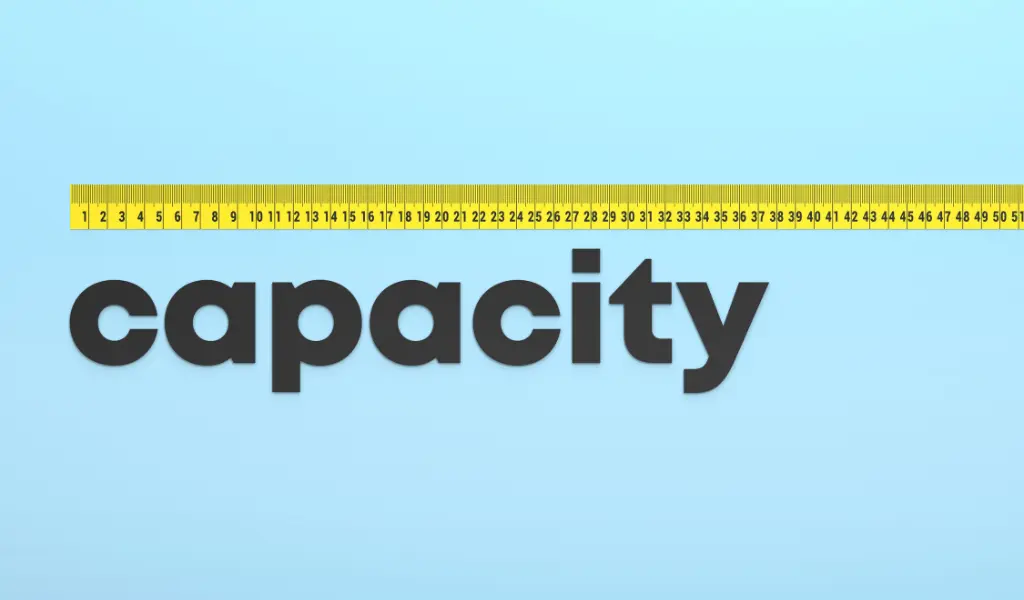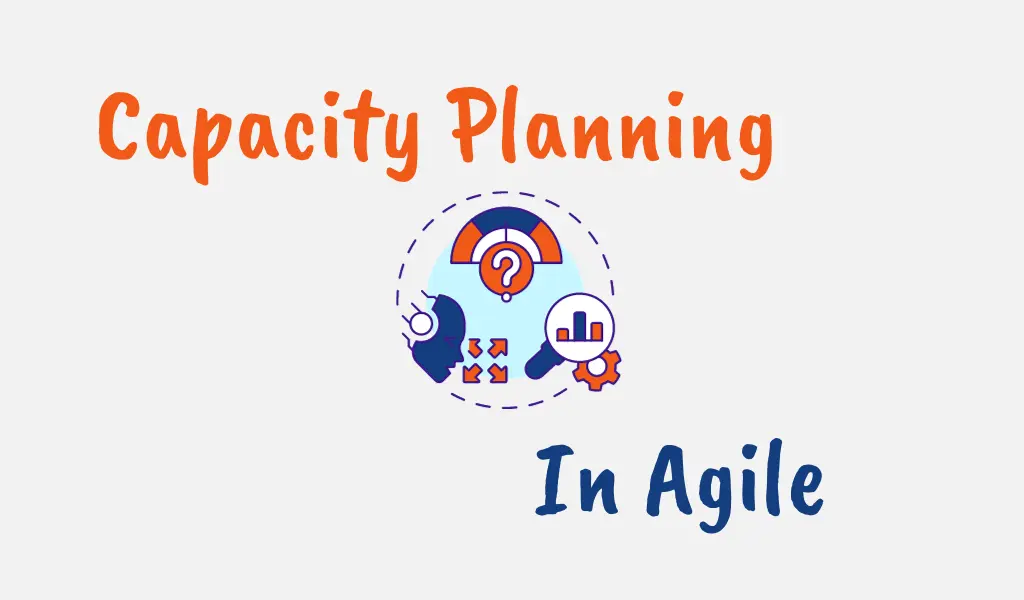Implementing Agile approaches like Scrum or Kanban can help streamline your projects and improve team productivity. But without proper planning, even Agile projects can fail.
That’s where capacity planning comes in. Knowing your team’s workload capacity is crucial for sprint planning and ensuring they can complete the work that they are committed to without getting overburdened.
In this article, we’ll lay into the concept of Agile capacity planning, and explore how you can leverage it for your Agile or Scrum Team to work efficiently and deliver value predictably.
What is Agile Capacity?
Agile capacity refers to the total productive time your Agile team has available to complete work during a Sprint. It determines how much of the Product Backlog they can realistically deliver.
Calculating your team’s capacity involves estimating their availability in hours and accounting for factors like vacations, meetings, and focus time. The goal is to find their true capacity for focused, uninterrupted work.
Agile capacity planning sets your team up for success by enabling them to commit to an appropriate amount of work.
Overcommitting leads to rushed outputs, technical debt, and burnout. Undercommitting on the other hand leaves time wasted. Accurately forecasting capacity promotes sustainable pace, high quality, and predictability.
Knowing their capacity helps your developers, testers, and other roles work efficiently as they can collaborate to select feasible backlog items and tasks to match the team’s bandwidth.
With an optimized workload, your Agile team can meet Sprint Goals smoothly.

What is Agile Capacity Planning?
Agile capacity planning is the process of determining how much work your Agile team can complete within a Sprint.
It involves estimating your resources’ availability, accounting for capacity factors, and selecting feasible backlog items to match.
Effective Agile capacity planning requires understanding your team’s velocity and capacity. Velocity measures your team’s typical throughput per Sprint in story points or tasks, while capacity considers their focused hours available.
By forecasting capacity upfront, you empower your developers, testers, and other roles to commit to realistic workloads reducing the risk of overcommitting your Scrum Team during Sprint Planning and promoting transparency between the Product Owner and team on what’s achievable.
Ongoing capacity planning enables continuous improvement too as you can adjust forecasts based on performance data and capacity trends across Sprints.

How to Calculate Capacity in Agile
Accurately calculating your Agile team’s capacity is crucial for realistic Sprint Planning and delivery, and sets your team up for success by enabling realistic commitments.
Follow these steps to forecast capacity in hours or story points:
1. Calculate Sprint Duration
First, determine your upcoming Sprint’s duration in working days. Account for weekends, holidays, and scheduled office closures so you consider only the actual working time.
For example, a 2-week Sprint from Monday 8/1 to Friday 8/12 has 9 working days excluding weekends.
2. List Team Members and Allocations
Next, list all members of your Scrum Team who will contribute during the Sprint. Note their expected allocation – are they dedicated full-time or splitting time with other projects?
This gives you clarity on true availability. Someone working on your project 50% of the time has obviously less capacity than one working full-time on it.
3. Estimate Standard Hours Per Day
For each member, estimate their standard daily capacity in hours. This is how much they can work on Sprint tasks in a typical day when 100% allocated.
Eight hours daily is common for full-time individual contributors. Reduce accordingly if they have partial allocation.
4. Account for Other Factors
Consider any Sprint-specific factors that may impact capacity, like:
- Vacations: Team members out of the office will have zero capacity on those days.
- Sprint Meetings: Account for time spent in ceremonies like Daily Standups, Sprint Planning, and Sprint Retrospectives.
- Training: Factor in any scheduled training or team events.
- Support Tasks: Handle each person’s expected time on things like email and IT support.
5. Apply a Focus Factor
Use a focus factor between 60-80% to calculate each person’s true daily capacity. This accounts for distractions and avoids overutilization.
A 75% focus factor means 6 hours’ focus time from an 8-hour day.
6. Calculate Total Capacity
With the above inputs, you can now calculate your team’s total capacity for the Sprint in hours.
Add each member’s focused capacity across all Sprint days. This is your team’s starting capacity.
7. Convert to Story Points
Optionally, convert your hourly capacity to story points using your team’s velocity data. Take the average story points completed per hour recently, then multiply by total hours to get the capacity in points.
8. Select Feasible Work
Compare your team’s capacity to size estimates for backlog items. Select a feasible scope to match the forecast capacity and get commitment from the team.
When to do Agile Capacity Planning
When should you conduct Agile capacity planning to prepare for an upcoming Sprint? The best practice is to complete capacity planning just before Sprint Planning begins.
Ideally, hold a capacity planning meeting 1-2 days before kickoff. This provides the necessary data to inform sprint commitments, without the results getting stale.
A dedicated meeting may not be required if your team’s capacity doesn’t fluctuate much from Sprint to Sprint.
In some cases, the Scrum Master can calculate capacity independently and provide the forecast during planning.
However, when factors vary significantly like changes in team composition, allocation, or Sprint duration, then it is best to come together as a team to review the inputs and assumptions.
Facilitate an open discussion around the current Sprint’s capacity and how to maximize focus. Then document conclusions to reference on Sprint kickoff day.
Remember to revisit capacity planning during the Sprint Retrospective too. Review your original forecast accuracy and identify process improvements for next time. Continuously refining your capacity planning approach is key.

Benefits and Importance of Agile Capacity Planning
Effective capacity planning is critical for Agile teams to work sustainably and deliver value predictably.
Here are some of its key benefits:
Increased Forecasting Accuracy
When your capacity estimates account for all availability factors and your team regularly meets commitments, forecasting precision improves over time. Furthermore, historical data enables high-confidence planning.
Accurate forecasts empower teams to plan workloads minimizing the risk of overburdening or underutilizing capacity, and ensuring that progress stays on track.
Reduced Risk of Overcommitting
Without visibility into true capacity, teams often overcommit during Sprint Planning and struggle to deliver. Capacity planning mitigates this risk by clarifying achievable scope.
This way, your developers can stay focused on finishing work to high standards, rather than getting spread too thin.
Improved Team Morale
Agile capacity planning promotes reasonable workloads, avoiding burnout. When teams work at a sustainable pace, morale and job satisfaction increase.
By protecting your team’s focus time, they can do deep work and gain a sense of accomplishment from completed items.
Better Predictability
Consistently matching commitments to capacity builds trust that teams will deliver as expected. Also, stakeholders gain confidence in release plans when sprints reliably meet forecasts.
This predictability helps the business align its capacity to strategic goals and make data-driven prioritization decisions.
Improved Prioritization
With clear visibility into the team’s capacity and velocity, Product Owners can make better Product Backlog prioritization decisions as they know what scope is realistically achievable in each Sprint.
Planning sprints at capacity can address the highest-value items first thus aligning work completed with business priorities.
Increased Trust
Consistently meeting Sprint forecasts builds trust between leadership and teams. Leadership knows what to expect, while teams feel empowered to push back on overloading.
This mutual trust is the foundation of psychological safety, engagement, and peak performance and is enabled through capacity planning.
Actionable Data
Trends and variances highlighted during capacity planning provide actionable data to improve processes. You can streamline ceremonies or adjust allocations to optimize capacity.
Data enables continuous improvement, and with concrete metrics, you can experiment and measure the impact of changes.
Higher Quality Work
By avoiding overutilization, teams have time to complete work thoughtfully and purposefully. Less rushing means higher code quality, less technical debt, and fewer defects.
When work matches confirmed capacity, quality is not sacrificed, and teams feel empowered to build things well.
Better Resource Planning
Knowing team capacity constraints and velocity helps identify resource gaps to fill through hiring or training. Capacity data improves resource planning and management.
You can projectively determine where bandwidth needs to increase based on the roadmap and scale your team appropriately.
Streamlined Processes
Teams can identify process waste through capacity data and fine-tune workflows. This leads to greater focus, reduced context switching, and smoother Agile cadences.
Any meetings or activities that drag on capacity can be restructured, consolidated, or eliminated to ensure that essentials are prioritized.
Enhanced Value Delivery
All of the above benefits compound to help Agile teams deliver maximum value efficiently. Proper capacity planning is critical to realizing Agile’s full potential.
By planning capacity upfront, teams can continuously improve to optimize throughput, pace, quality, and predictability.
Challenges of Capacity Planning in Agile
While proper capacity planning offers many benefits, it also comes with some common challenges including:
Priorities and Scope Changes
The dynamic nature of Agile means priorities and scope often change between planning and execution. This can impact capacity assumptions and throw off forecasts.
Stay agile by reviewing capacity factors before each Sprint to realign commitments. Have contingencies for mid-sprint priority shifts too.
Hidden Work
It’s hard to account for every possible distraction during capacity planning. Unexpected issues or support tasks can take time away from Sprint work, reducing focus time.
Build in buffer time for hidden work by assuming less than 100% utilization when calculating capacity. Then monitor distractions to continuously improve estimates.
Persistent Overcommitment
Some cultures perpetually overcommit, even with capacity planning. Also, leadership may push teams to take on more work than they can handle.
Empower teams to firmly communicate when work exceeds confirmed capacity and advocate for solutions, like reduced scope or more resources.
Inaccurate Estimating
Task size estimating errors can lead to mismatches between planned work and actual capacity. Incomplete information or cognitive biases can also lead to bad estimates.
Retrospectively analyze estimates versus actuals and guide teams to use objective data-driven techniques for estimating improvement.
Changing Team Composition
For teams where composition fluctuates frequently, historical velocity and capacity become less predictive as members change each Sprint.
Maintain allocation clarity and re-forecast any impacted capacity when membership changes. Also, consistently apply velocity metrics.
Manual Processes
Calculating capacity across projects and Sprints can be time-consuming without the right tools. Data is disconnected and hard to analyze.
Consider adopting Agile management software with integrated capacity planning capabilities to save time and enable data-driven decisions.

Agile Capacity Planning Best Practices
Follow these tips to improve your team’s Agile capacity planning process:
Involve the Entire Team
Conduct capacity planning as a collaborative exercise, not just a Scrum Master task. Engage your full cross-functional team, including developers, testers, designers, etc.
Broad participation results in more accurate forecasts and shared ownership of commitments. Team knowledge improves the process over time.
Use Historical Data
Leverage your team’s past performance data to inform capacity estimates. Review velocity trends from previous Sprints and actuals versus plan.
Data-driven forecasting is more reliable than guesses. You can build a spreadsheet to track key capacity metrics Sprint over Sprint.
Account for All Capacity Factors
Take into consideration any events, trainings, support work, ceremonies, or holidays that might affect the number of hours available for actual Sprint work.
Create a master list of capacity considerations and modify it according to your team and organization while planning.
Assume 80% Utilization
Instead of using 100% utilization, aim for an 80% utilization rate to prevent fatigue and leave room for distractions.
Refrain from overcommitting even in cases where your capacity calculation is high, and include a margin.
Commit as a Team
During Sprint Planning, the entire Scrum Team should commit to the task selected for the Sprint.
Before confirming the commitment, ensure that there is a shared knowledge of the scope and alignment on feasibility.
Limit Work in Progress
Another key practice is resisting the urge to multitask or take on additional work before finishing committed items first.
Focus on completing Sprint work to maintain trust, accuracy, and predictability.
Review Regularly
Analyze your capacity forecast versus actuals during the Sprint Retrospective. Then identify process improvements to increase accuracy.
Capacity planning is a skill that improves over time so continuously refine your data tracking, assumptions, and estimating methods.
Automate Where Possible
Use Agile software tools to simplify data tracking and analysis as automated reports save time over manual methods.
Integrate capacity metrics across Sprints to spot trends. Then add key data to Sprint boards for visibility.
Following these best practices will optimize your capacity planning process. The more accurate your forecasts, the better equipped your Agile teams will be to meet goals predictably.

Capacity Planning Example in Agile
Let’s walk through an example of Agile capacity planning for a Scrum Team.
The Sprint duration is 2 weeks, running Monday 8/1 to Friday 8/12. That’s 10 working days excluding weekends. The cross-functional team has:
- 2 developers working 8 hours per day
- 1 tester working 8 hours per day
- 1 designer working 6 hours per day
However, the designer has 2 days of PTO during the Sprint.
So the standard hours per day when all are present is 22 (16 from developers, 8 from the tester, and 6 from the designer).
Accounting for PTO, the designer has 4 fewer hours on those days. So adjusted hours per full day is 18.
Assuming an 80% utilization rate for a buffer, the daily focus capacity is 14 hours.
Over 10 Sprint days at 14 focus hours per day, the total capacity is 140 hours.
During Sprint Planning, the Product Owner proposes 120 hours worth of backlog items.
The team discusses the work and agrees the full 120 hours can be reasonably completed within their 140-hour capacity.
So they commit to that scope for the Sprint. Effective capacity planning gives the team confidence they can deliver on their commitment without overburdening resources.
After the Sprint, they will retrospect on accuracy and identify any process improvements for next time. Continuously refining the approach will increase predictability over time.

Agile Capacity Planning Tools
While capacity planning can be done manually, Agile management software provides automation and insights.
Here are some popular tools with integrated capacity planning:
Jira
Jira offers capacity planning features through its native integration with Tempo Timesheets. Teams can log time spent on sprints to compare capacity versus actuals.
The Tempo Planner tool helps visualize team utilization and identify under- or over-allocation.
Azure DevOps
Azure DevOps has built-in Sprint capacity planning to forecast the number of hours available per person. Capacity charts roll up for total team views.
Teams can compare effort estimates to available capacity to ensure feasible Sprint commitments.
Smartsheet
Smartsheet provides a capacity planning template to track resources across projects. The dashboard calculates capacity versus demand.
Factors like holidays and utilization rates can also be configured for accurate forecasting. While automated alerts notify on overallocations.
Miro
Miro’s infinite virtual whiteboard can be used by Agile teams for collaborative capacity planning workshops.
Sticky notes help map out all inputs and assumptions visually and real-time collaboration streamlines alignment.
Monday.com
Monday.com offers an Agile Capacity Planning board template with columns to track capacity factors like vacations, allocation percentage, and focus time.
Charts provide visibility into utilization and forecasted capacity across Sprints.
Leveraging these purpose-built tools simplifies capacity planning with automation, organization-wide visibility, and insights. Evaluate options to determine the best fit for your team’s needs and workflows.
Agile Capacity vs Velocity
Agile capacity and velocity are two important metrics that help teams plan and forecast work.
While they work together to optimize planning and forecasting, they are distinct and measure different aspects of team output as seen below:
Purpose
The purpose of tracking capacity is to determine the maximum amount of work a team can commit to in an upcoming Sprint. It focuses on their available time and resources.
In contrast, the purpose of tracking velocity is to forecast how quickly a team can work through the backlog based on historical throughput to provide visibility into the delivery rate.
Measurement
Capacity is measured by estimating the total focused hours or days each team member has available for the Sprint duration and summing them. Parameters like vacations and ceremonies are factored in.
On the other hand, velocity is measured by calculating the average volume of story points the team has fully completed per Sprint in recent iterations. It is defined by actual throughput.
Insights Provided
Capacity is a supply-side metric that provides insights into the availability of human resources on the team currently.
Velocity is a demand-side metric that provides insights into the team’s demonstrated productivity based on past performance.
Agile Capacity vs Resource Planning
Agile teams must plan effectively on two fronts – both on the short-term iteration level and the longer-term project level. Two key activities enable this: capacity planning and resource planning.
While complementary, these processes differ in some important ways:
Timeframe
Capacity planning is a short-term oriented process that happens at the iteration level to determine availability for the upcoming Sprint.
Resource planning is more long-term focused at the project or portfolio level. It ensures you have the right roles and skills over months.
Inputs Considered
Capacity planning accounts for existing team members’ availability in hours for the specific Sprint duration based on allocations and the company calendar.
Conversely, resource planning considers desired delivery velocity, overall backlog size, and roadmap to determine the ideal headcount and skills over time.
Scope
Capacity planning is limited to forecasting the bandwidth of current team members for committed work versus their capacity.
Resource planning on the other hand encompasses hiring, contractor hiring, training, and budget to scale teams and skills for initiatives.
Outcomes
The outcome of capacity planning is a commitment of scope for the Sprint matching confirmed resources.
Whereas the outcome of resource planning is having a staffing model, hiring plan, and development programs to meet program needs.
Despite these differences, it’s important to note that capacity planning informs resource planning. Known capacity gaps help determine hiring and training priorities to scale Agile teams. Doing both well helps Agile teams optimize throughput.
Final Thoughts
By accurately forecasting capacity needs based on historical data, upcoming requirements, and environmental factors, you empower your Agile teams to take on the right amount of work sustainably.
Refine your capacity planning processes iteratively and integrate them into broader resource planning to scale capabilities.
With the ability to reliably anticipate and match capacity to business priorities, you set your teams and company up for agility and success.
FAQs
Does Scrum Master do Capacity Planning?
No, capacity planning is a team exercise. While the Scrum Master may facilitate the process, the entire cross-functional team should provide input on capacity factors and assumptions. Planning capacity together improves forecast accuracy and shared commitment.
Why is Capacity Planning Important in Agile?
Capacity planning is critical in Agile to ensure teams don’t over-commit during sprint planning. Understanding true capacity based on availability and historical velocity enables teams to forecast work and stick to sustainable pacing. This improves predictability, quality, and team morale.
How do you Calculate Capacity in Agile?
To calculate capacity in Agile, tally the expected focused hours each team member has available for the sprint duration based on standard hours and capacity factors like PTO or support work.
Multiply by utilization percentage (often 80%) to determine total team capacity for new sprint commitments.
Does Jira do Capacity Planning?
Yes, Jira has native capacity planning capabilities through its integration with Tempo Timesheets. Teams can log hours worked on sprints to analyze capacity versus actuals. The Tempo Planner adds utilization charts and helps identify under/over allocation.
Who does Capacity Planning in Scrum?
The entire Scrum Team collaborates on capacity planning, bringing the collective knowledge of developers, testers, designers, etc. together which results in the most accurate understanding of true team capacity for sprint commitments.





